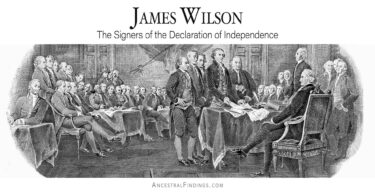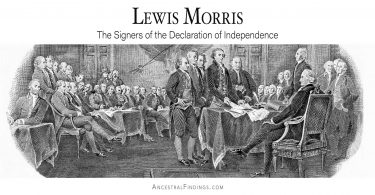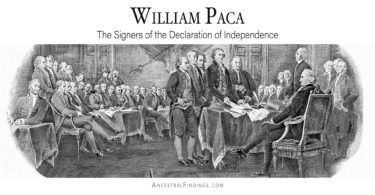Thomas Heyward, Jr. was born in July of 1746 in St. Luke’s Parish in what is now Jasper County, South Carolina. His parents were Daniel Heyward and Mary Miles. Thomas used “Jr” after his name to distinguish himself from his father’s brother, who was also named Thomas. His parents were wealthy planters, and Thomas himself was part of the fifth generation of the Heyward family in the American colonies.
The initial ancestor of the Heyward family to come to the colonies was also named Daniel, like Thomas’s father. This Daniel came to the colonies in 1670 and settled in what later became South Carolina, having originally come from the village of Little Eaton, near the town of Derby in the midlands of England.
Thomas was initially educated at home, then sent to local schools, and finally went to England to study law. While in England, he became a member of the Honourable Society of the Middle Temple. His family was one of the few in the American colonies to be granted a patent for Arms. This patent was issued directly to Thomas in December of 1768 by the Heralds College in London, while he was still studying law at Middle Temple in London. While Thomas received the patent for the Arms, the actual Arms and Crest design were issued to his father, Daniel.
After graduating with his law degree, Thomas went on a tour of Europe. This was an opportunity that was not afforded to very many colonial American men at the time. While on his tour, Thomas came to appreciate the simple, hardworking ways of his countrymen in the colonies, comparing them unfavorably to the luxurious, decadent, and often lazy lifestyles of the upper classes that he encountered on the European continent. He also became resentful of how people from the colonies were treated as second-class citizens in England when they were technically just as British as the people who were born in Great Britain. By the time he came home from his tour, Thomas was firmly of the belief that the American colonies should be independent of their mother country in England.
Upon returning home to South Carolina, he began to practice law, and was outspoken in his beliefs in the cause of liberty. Thomas was one of the earliest people in South Carolina to prominently oppose the British Stamp Act. He continued to promote the cause of liberty with great firmness up until the Battle of Lexington that kicked off the Revolutionary War. Thomas even publicly repudiated Britain’s terms of peace with the colonies—which was the colonies’ unconditional submission to the crown—as being utterly degrading. Because he was so open in his contempt for the role the colonies played in the landholdings of England, Thomas eventually became a leader of the Revolutionary movements in South Carolina. This put him in opposition to his father, who was a staunch Royalist.
Because of his Revolutionary leadership, Thomas was chosen to be in the first General Assembly that came together after the abdication of the colonial governor. As a member of the General Assembly, he was made a member of its very first Committee of Safety. Thomas was in this role when, at the age of only twenty-nine years old, he was elected as a delegate from South Carolina to the Second Continental Congress in Philadelphia, to replace the outgoing John Rutledge. Thomas arrived at the Congress just in time to take part in the debates on American independence that were taking place there.
Thomas happily signed the Declaration of Independence, shortly after arriving at the Continental Congress, and only a few days after turning thirty. This move did not please his father, who told him that the British would probably hang him for that act. Though they differed in their politics, Thomas and his father were not estranged for long, and had fully reconciled with each other before his father crossed over to the other side the next year after the Declaration was signed.
After serving on the Continental Congress for a while, Thomas returned home to South Carolina in 1778 to serve as a judge there. During the Revolutionary War, he was assigned the command of a militia force and was taken prisoner by the British during the siege of Charleston. He was soon released and was elected as a member of the American Philosophical Society in 1784. He also continued to serve as a judge after the war, until he retired in 1798.
As far as his personal life goes, Thomas was married twice. The first marriage took place when he was twenty-six years old and was to a woman named Elizabeth Mathews. Elizabeth died in childbirth in Philadelphia in 1782, where she had gone to be with Thomas after he was released as a prisoner of war by the British. Thomas and Elizabeth had six children together, but only one, a son named Daniel, survived childhood. Thomas married a second time when he was forty years old, also to a woman named Elizabeth, this time Elizabeth Savage. They had three children who survived childhood. Among the four total children of Thomas to survive childhood, they left a number of descendants, and some of these lines of descent continue into the present day.
Thomas died in March of 1809 and was buried at the Old House Plantation, located close to Ridgeland, Jasper County, South Carolina. This plantation house was put on the National Register of Historic Places in 1997. The government of South Carolina added a large marker and bust of Thomas to his gravesite some decades after he was placed there. His first wife is buried at St. Peter’s Churchyard in Philadelphia, while the burial place of his second wife is unknown, but is presumed to be the same place Thomas is buried, as at least one of their children is buried there, too.
There is a school named after Thomas in Ridgeland, South Carolina, called Thomas Heyward Academy.





